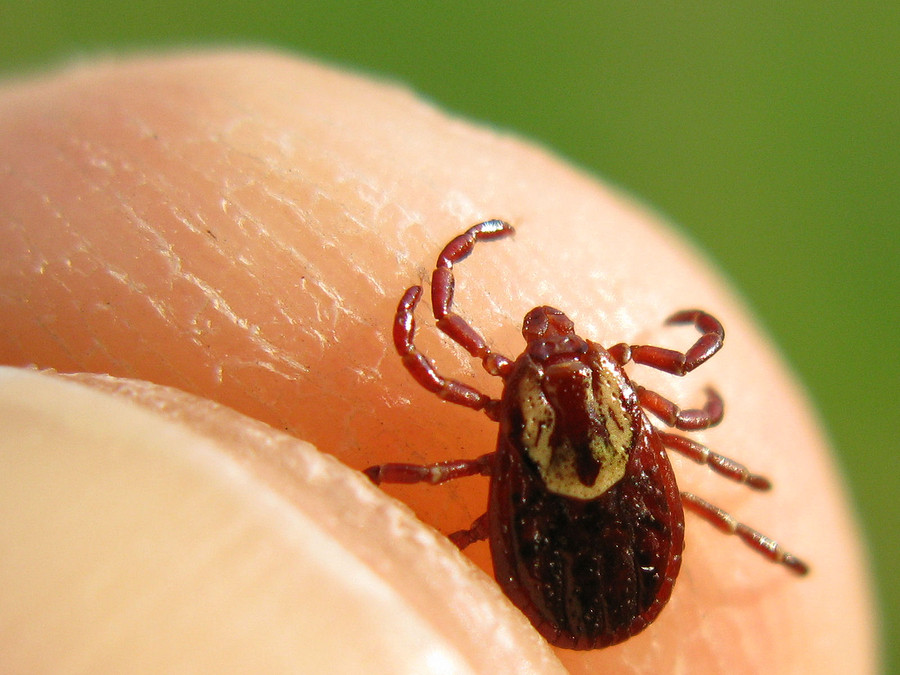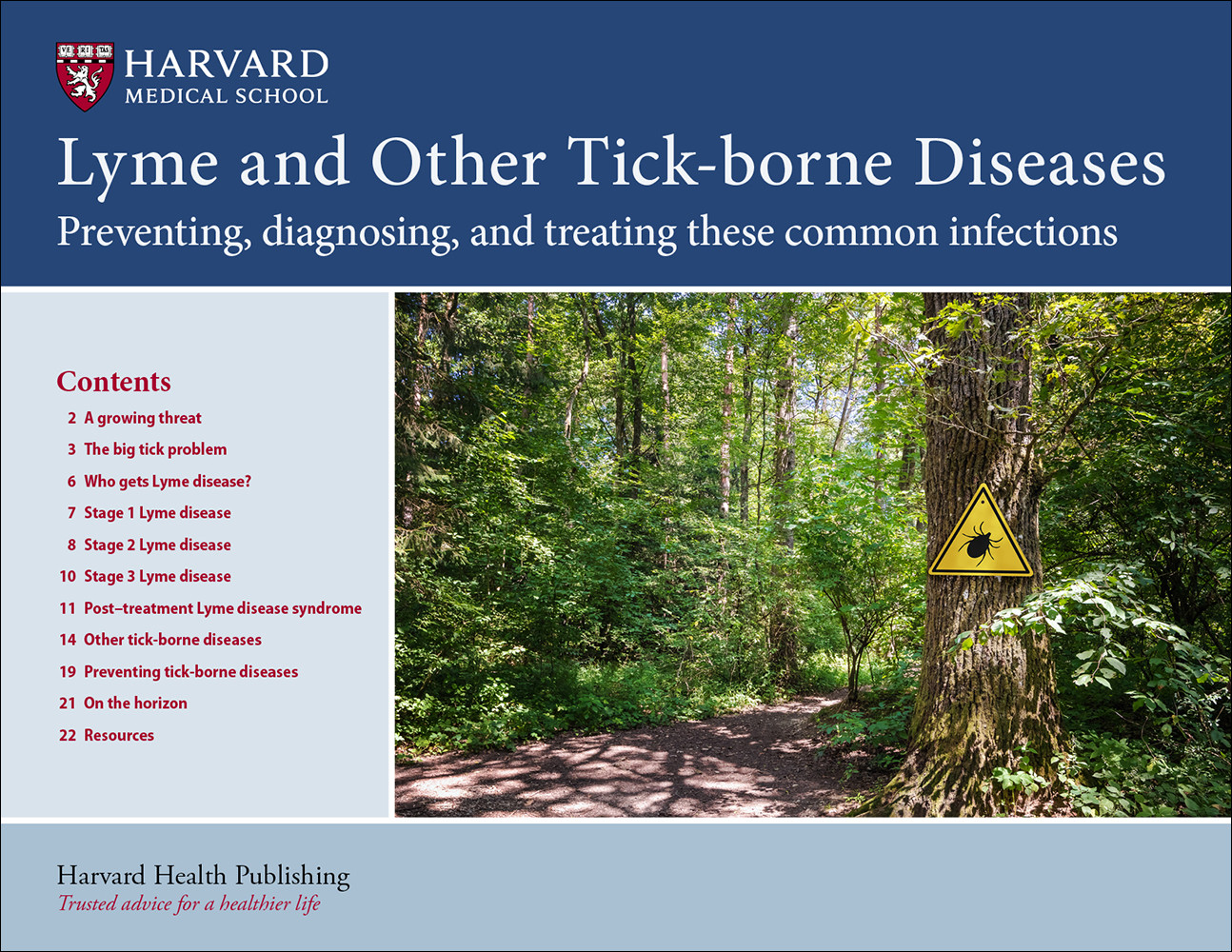
5 timeless habits for better health

What are the symptoms of prostate cancer?

Is your breakfast cereal healthy?

When pain signals an emergency: Symptoms you should never ignore

Does exercise give you energy?

Acupuncture for pain relief: How it works and what to expect

How to avoid jet lag: Tips for staying alert when you travel

Biofeedback therapy: How it works and how it can help relieve pain

Best vitamins and minerals for energy

Should you take probiotics with antibiotics?


Lyme and Other Tick-Borne Diseases: Preventing, diagnosing, and treating these common infections
This guide examines the challenges of prevention and diagnosis of tick-borne diseases to help you seek the most appropriate treatment for your symptoms. It examine ticks, their life cycles, and some of the diseases they spread, such as babesiosis, ehrlichiosis, and Rocky Mountain spotted fever. The guide takes a close look at Lyme disease, including diagnosis, treatment, and prevention.
Other Product Information
If you live in or even visit an area where there are grassy fields, bushes, and animals like deer, rabbits, squirrels, birds, and mice, you are probably at some risk of acquiring Lyme disease or another type of tick-borne disease.
Data suggests there are as many as 400,000 cases a year. The tick season is longer. The range is wider. The highest rates of Lyme disease are occurring with 8-to-14-year-olds and adults 60 to 80.
Lyme disease is, quite frankly, something to be aware of, not scared of. You can take steps to prevent ticks and to assure effective, swift countermeasures should a tick-borne illness occur.
Lyme and Other Tick-Borne Diseases shares specific ways to reduce contact with eight common types of ticks. It reveals the essentials of an accurate diagnosis. And it briefs you on the most effective treatment protocols.
Smart and simple steps to deter, detach, and defeat ticks
In this downloadable report, you’ll find proven tips to prevent a tick bite. You’ll discover two easy-to-use products that repel ticks from clothing. You’ll learn a slick trick to loosen a tick’s grasp… the five most common bite areas (including the two that are often overlooked)… and one step that can successfully and quickly prevent a Lyme infection if one is considered likely.
The smartest tools and tests for detecting Lyme — even without the bullseye!
The bullseye rash appears in as few as 60% of Lyme cases. An early blood test will not be positive, even if you are infected. So how do you get a reliable test? The Guide will tell you. You’ll find an antibody test that’s nearly 100% accurate. You’ll learn the Stage 2 symptoms doctors look for… an internet test kit you should avoid… and the CDC’s latest testing recommendations.
Treatment choice to ease and end symptoms quickly and completely
The Guide offers clear guidance for working with your physician to initiate the best treatment.
You’ll find the preferred antibiotics for Lyme disease. You’ll discover healing strategies for late Lyme disease… a multidisciplinary approach to speed recovery from a chronic Lyme condition… and more.
Plus, protective measures to guard against 9 other tick-borne illnesses
You’ll learn where Rocky Mountain Spotted Fever is the greatest danger (It’s not the West.) You’ll be alerted to one disease that requires a precise combination of antibiotics… a tick infection that mimics malaria… and the one tick-triggered disease with infection rates that spike in winter.
Prepared by the editors of Harvard Health Publishing in consultation with Daniel A. Solomon, M.D., Assistant Professor of Medicine, Harvard Medical School; Physician, Division of Infectious Diseases, Brigham and Women’s Hospital. 22 pages. (2023)
About Harvard Medical School Guides
Harvard Medical School Guides delivers compact, practical information on important health concerns. These publications are smaller in scope than our Special Health Reports, but they are written in the same clear, easy-to-understand language, and they provide the authoritative health advice you expect from Harvard Health Publishing.
Tick bite prevention tips
Although prompt removal of ticks can prevent transmission of Lyme, the best way to avoid tick-borne disease is to prevent bites. Taking the following steps can help protect you and your family.
Know when you are at highest risk. Use particular caution when walking through fields or meadows where there is grass that grows taller than your socks and hikes where you will be brushing up against bushes, leaves, or trees. Typically, ticks are transmitted from leaves or blades of grass on the ground to the legs, where the ticks crawl up.
Wear protective garments. The best protection is long pants tucked into socks to keep ticks from crawling up under the pant leg. Lighter-colored clothing can make ticks easier to see.
Use repellents. Treat clothes with permethrin (Nix, Rid) to repel ticks and discourage them from attaching. Treating skin with DEET products may be helpful as well. Follow directions carefully. Inspect each other. Have a partner check you for ticks, to look in those dark areas where it’s hard to see. Pay special attention to the armpits, neck, scalp, ears, backs of the knees, groin, and navel (belt area). An adult I. scapularis tick is about the size of a sesame seed.
Remember that ticks don’t bite right away. They crawl around on the skin looking for the best place to settle. This gives you an opportunity to get rid ofthem first. After you come inside from outdoors, take off all clothes and put them straight in the dryer on high heat for 10 minutes to kill any ticks that may be on them. Then get in the shower to allow water to simply wash away any unattached ticks that may be crawling around on your skin.
Remove ticks. If you do find an attached tick on the body, remove it as quickly as possible to prevent the risk of transmission of B. burgdorferi.
Tick-borne diseases are becoming more common, and the range of affected areas is spreading. Your best chance of avoiding the potentially serious long-term consequences of these diseases is to practice protective measures when you go outdoors to keep ticks from having the opportunity to bite, and to do routine tick checks when you come back inside.
If you do find and remove a tick, consult with a doctor if you think it might have been attached for more than a day or so. Finally, if you do develop the characteristic bull’s-eye rash or other signs of Lyme or another tick-borne illness, seek medical attention immediately.
- A growing threat
- The big tick problem
- Who gets Lyme disease?
- Stage 1 Lyme disease
- Stage 2 Lyme disease
- Stage 3 Lyme disease
- Post–Lyme disease syndrome
- Other tick-borne diseases
- Preventing tick-borne diseases
- Resources

5 timeless habits for better health

What are the symptoms of prostate cancer?

Is your breakfast cereal healthy?

When pain signals an emergency: Symptoms you should never ignore

Does exercise give you energy?

Acupuncture for pain relief: How it works and what to expect

How to avoid jet lag: Tips for staying alert when you travel

Biofeedback therapy: How it works and how it can help relieve pain

Best vitamins and minerals for energy

Should you take probiotics with antibiotics?
Free Healthbeat Signup
Get the latest in health news delivered to your inbox!
Sign Up